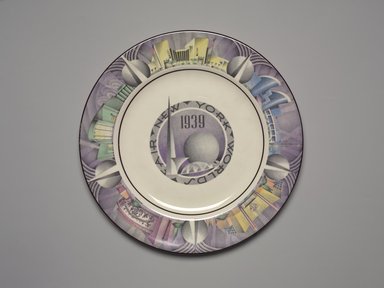Browse

| Accession # | 1994.165.75 |
|---|---|
| Manufacturer | Homer Laughlin Company |
| Designer | Charles Murphy |
| Title | Plate (New York World's Fair) |
| Date | ca. 1939 |
| Medium | Eartthenware |
| Dimensions | 3/4 x 10 1/8 x 10 1/8 in. (1.9 x 25.7 x 25.7 cm) |
| Marks | On reverse, underglaze green: (monogram logo) "HLCC / HOMER LAUGHLIN / MADE IN USA". Gilded, printed in convex semi-circle: "DECORATION BY CHARLES MURPHY / 150th ANNIVERSARY / INAUGURATION / [horizontal] OF / GEORGE WASHINGTON / -AS- / FIRST PRESIDENT / OF THE UNITED STATES / [concave semi-circle] 1789-1939" |
| Credit Line | Gift of Paul F. Walter |
| Location | Visible Storage: Case 18, Shelf C (Contemporary Design) |
| Description | Plate. Glazed cream-colored earthenware, polychrome printed decoration. 1939 New York World's Fair souvenir. Metallic brown edging around rim. Multi-colored printed decoration to rim is divided into five segments by fair symbols, Trylon and Perisphere, with out curving rays from top. Five exhibition halls from fair are depicted within. Clockwise from top: Federal Government Building; Marine Transportation Building; Hall of Communications; Food Exhibitors Building; and the Building of Contemporary Arts. Background of rim decoration is predominantly purple with beams of lighter purple running through. Center of plate has purple Trylon and Perisphere on darker purple circular background. "1939" above Perisphere. Tip and base of Trylon bisect encircling purple on lighter purple inscription: "NEW [inverted triangle] YORK [inverted triangle] WORLDS [inverted triangle] FAIR [inverted triangle]". Condition: Good; gummy residue to rim and back; minor scratches to back. |
Curatorial Remarks: This plate is a souvenir from the 1939–40 New York World’s Fair. Unlike the Seminole doll and Vili tusk, which members of those communities made, a New Yorker did not make this plate. Designed by Charles Murphy, the mass-produced plate features his Art Deco-style painting of the fairgrounds. At the center is his depiction of the futuristic Trylon and Perisphere structures; fair pavilions ring the perimeter. Just as the ivory tusk reflects a transitional period in Vili culture, Murphy’s plate represents America’s focus on the future late in the Great Depression. Plates such as this were meant to be displayed in cabinets or on walls.